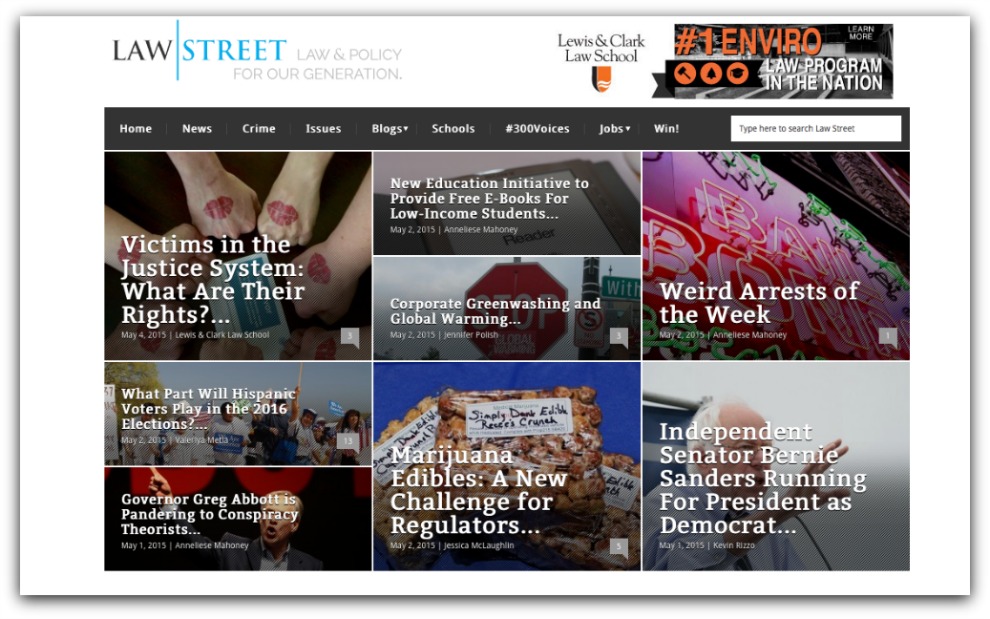When John Jenkins was a journalism student minoring in government at the University of Maryland in the early 1970s, his favorite magazine was the Washington Monthly, a wonky title noted for its deep dives into bureaucracy.
“It had great stories, really important stories,” he said. “I realized [they were] not being covered by the average daily press corp. And I wanted to change that.”
Jenkins went on to have a successful career in media, serving 15 years as president and publisher of CQ Press and authoring three books about lawyers, including a biography on William Rehnquist, the late Supreme Court chief justice.
Now Jenkins, 65, is working on filling that void he first noticed 43 years ago by creating an Internet news service that brings deeper stories about law, public policy and related issues to millennials.
Launched in 2013, his startup, Law Street Media, is exploring how to convey important, complex issues to readers 35 and under in a more lively, engaging way than traditional media.
“We write about anything in the law and policy worlds that would be of interest to readers of our generation–what bits of information would they want to know?” said Chelsey Goff, 30, Law Street’s chief people officer. “What angle would grab them the most? And that’s not always a listicle.”
Jenkins believes one crucial way to reach young readers is on mobile. “The most ubiquitous device that people can use to get information is their phone,” he said. “I wanted to create a specialized reporting experience that would be looked at by people whenever they wanted content, not when it showed up on their doorstep like the morning paper. I wanted to create something that was mobile, millennial and free.”
Translating Law and Policy into Lively News
Law Street employs roughly 10 people in offices in Washington D.C. and New York. Its young staff—everyone but Jenkins is a millennial–works with freelance contributors and 44 bloggers to produce around eight stories a day, typically revolving around crime, law and policy. Editors and writers work together around a big conference table in D.C. from 9:30 a.m. to 5:30 p.m. five days a week. A weekly conference call helps employees make decisions and maintain a transparent management structure.
The home page at Law Street is a picture grid with the day’s top stories. Headlines are catchy: “TSA Has Secret Checklist to Spot Terrorists. Hint: Don’t Yawn at Security;” “Peek-a-Boo! Cops Find Crook Who Snapchatted His Location; ” and “ISIS Uses Twitter to Publish Hit List of U.S. Military Personnel.”
Developing a Millennial News Style
The fun and clever style Law Street uses caters to the way millennials are reading news, which includes more sharing on social networks and a content mix that blends facts with entertainment, humor and commentary.
While millennials appear to be spending less time with news than their elders, research suggests a bigger change may be in how they find and interact with it.
A 2012 Pew Research study found millennials typically spend 46 minutes a day with news, far less than the 84 minutes spent by the so-called Silent Generation. Yet an American Press Institute (API) study this year found most millennials are interested in news: 69 percent of them get news at least once a day and 40 percent do so several times daily.
The study further noted that young readers are drawn into news by peers who recommend or contextualize it via social networks and private messages; many then “dig deeper” with Internet search engines and visits to favored news sites that offer relevant links.
Jenkins wants Law Street to be one of those favored sites, and he is hardly alone. Scores of other entrepreneurs have launched media ventures aimed at attracting young audiences—BuzzFeed, Wired, Vice, Mic, Vox and Elite Daily, to name just a few.
Not everyone sees the wisdom of catering to young audiences on general news, particularly in a field where the competition intensifies every year.
“I’m a little skeptical that millennials will prove to be that radically different and unique an audience as their predecessors,” said Mark Potts, a veteran journalist and news entrepreneur who was one of the founders of the Washington Post’s website. “I worry that if you’re only shooting for that segment, you’re going to be constantly churning your audience as they get older and you have to find new readers to replace them. I’d rather build long-term, lasting relationships.”
Deep Dives Into Weighty Topics
But Jenkins remains confident, contending that what sets Law Street apart is its focus on important and deep issues. In addition to shorter stories on current topics that most millennial sites offer, his writers craft longer, discrete overviews and explainers on complex issues like school bullying, fracking, diversity on TV, E-Cigarettes and the science of wine tasting.
The issue takeouts use a formulaic approach to address the pros and cons of bigger problems millennials care about. They are packed with multimedia storytelling including videos, links to relevant resources and listicles conducive to mobile reading.
One story titled “Cultural Appropriation: What’s Appropriate?” offers photos, a definition of cultural appropriation, video interviews with rapper Azealia Banks and YouTube commentator Justin Howells and two case studies, including one of Miley Cyrus’s “We Can’t Stop” music video.
Still, Potts wonders if the site is different enough. “I’m not sure about Law Street’s focus – its definition of ‘law and policy’ seems to include things like the new host of ‘The Daily Show’ and Jay-Z’s new music service,” he said. “There’s a lot of coverage on those topics elsewhere – Law Street has to distinguish itself by providing unique coverage.”
Getting Started: Two Teams, Two Cities
When Jenkins started the company, he formed two planning teams–one in Washington and one in New York City–who brainstormed what the service would look like in rooms full of white boards. “What would you, if you were in this audience, want to see?” Jenkins recalled asking his employees.
In the summer of 2013, they advertised for contributors and student interns and soon found more employees, a young crew who could write and edit for their own generation. By July, Jenkins introduced the two planning groups to each other, and they merged their ideas to produce one website.
Jenkins provided the initial funds to start the company himself, and he is in the process now of seeking outside investors. At this point, Law Street’s business model relies on advertising, but he said a subscription model is also under consideration.
Jenkins is pleased with the response the website is getting–400,000 page views per month, he said, with 79 percent of users accessing the site on their phones. And the demographics appear to be on target–55 percent of its readers are 35 or under.
Is the audience big enough to support a successful media business?
“That’s really not a lot of traffic,” Potts said. “To make the site’s advertising model…work, it has to attract a larger audience and keep them around longer.”
Potts also noted a weak social media presence—the site has more than 760 Twitter followers and nearly 2,000 likes on Facebook. “The millennial audience Law Street wants lives on social media, and it needs to be much more visible there,” he said.
The Law Street team acknowledges its limitations. Their initial brainstormers had dreams of creating a community where readers could participate in storytelling and communicate with one another and the site’s writers. Similarly, the team envisioned more video content. Financial limitations jolted them back to reality.
“We always have greater ambitions than the resources to do them, but that’s less of a problem than a goal to work toward,” Goff said.
For now, Law Street employees work with what they have. They use strong reporting skills to dig deeper and spin traditional stories for a young audience, while encouraging bloggers to show their personalities in their writing. Bloggers are allowed to be opinionated in order to engage readers, and other writers are encouraged to have fun with their work, employing playful tones and language that give off the young vibe the site is going for.
“Our readers are engaged, savvy and interested in the most important current events and legal news of our time,” Goff said. “We write in that sweet spot.”










